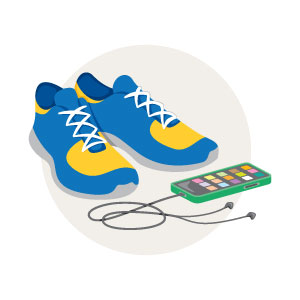
Sometimes the smallest moments of joy are the only ones that feel possible. That’s what Nora McInerny learned in 2014, when she lost her 35-year-old husband and her father to cancer and her second baby to miscarriage—all within the span of eight weeks.
Her husband, Aaron, was a “naturally buoyant person,” says McInerny, who’s the host of the podcast Terrible, Thanks for Asking and author of the upcoming book Bad Vibes Only. “He just had this otherworldly ability to find the fun and the joy in anything,” she says. “I learned from him the importance of staying as present as possible in the moment, even when the moment sucks. Even as he was literally dying, he could make me laugh.” (Among Aaron’s final words to his wife: “I will always be with you … so you need to stop picking your nose.”)
It was a moment she remembers with levity, plucked out of an unbearable time. During these past few years—plagued by political strife, social unrest, and, well, an actual plague—many of us have struggled to even briefly escape morose moods. But experts say that incorporating just a little bit of joy into our lives can disproportionately enhance our well-being by reducing the risk of chronic illness, strengthening the immune system, and combating stress.
“I think joy feels sometimes like a really big emotion—like crazy happiness,” McInerny says. “But it can be a small point of light in the darkness. It doesn’t have to be throwing the light on in the dark.”
Remind me—what’s joy again?
Joy is the state of feeling freedom, safety, and ease. Unlike some other positive emotions, like compassion and contentment, experiencing joy often depends on preparing for it, rather than spontaneously feeling it, says Philip C. Watkins, a professor of psychology at Eastern Washington University who’s authored many of the leading research papers on joy.
One of the best ways to usher in joy is to strengthen bonds with friends and family. “The most intense joy experiences are probably experienced in relationships,” he says. Filling your life with meaningful goals and purpose is also essential, Watkins notes, as is cultivating an open mindset—and not just to the good stuff. “If you’re open to joy, you have to be open to disappointment,” he says. “Paradoxically, in terms of experiencing joy, there has to be a willingness to experience loss and sadness.”
If you’re not sure how to go about sparking joy, start with some self-reflection, advises Brie Scolaro, a licensed social worker and co-director of the New York City-based and LGBTQ-focused Aspire Psychotherapy. First, take an inventory of what joy means to you, and when you last experienced it. Ask yourself: What’s standing in your way of feeling joyful?
Then, think back on your favorite, happiest moments. Doing so will trigger some of that same joyful energy (just as reflecting on sad memories will make you feel upset). It will also give you a hint of how to achieve more joy in the future.
Next, “make a plan to bridge the gap between what you know brings you joy and what you’re currently feeling,” Scolaro says. What actionable steps can you take today to increase your odds of experiencing joy?
Finally, make sure you’re present enough to soak in joy when it washes over you. “Are you listening to your friends speak? Are you tasting the beer that you’re drinking? You have to be able to register joy,” Scolaro says. “Joy is in the moment. Building the capacity to move back to the present moment—like through meditation—is the best way I can think of to be present to joy.”
Here are a few ways to achieve small moments of joy in dark times.
More from TIME
Make a joy bucket list
Robin Shear, a life coach, speaker, and author based in Detroit, has an emergency plan for those inevitable times when everything feels awful. Instead of spiraling—and it would be so easy to hop on the merry-go-round of doom—she turns to her “joy bucket list,” a tally of all the things that make her joyful: test-driving fast cars, being spontaneous, sharing new experiences with her family. She suggests others do the same, storing it in their phone or some other easily accessible place.
Having a physical reminder is helpful, “because there will be times in your life when you don’t feel joy. When life really hurts—and when you’re needing to rise out of that—it can be difficult to think about what will bring you joy again,” says Shear. “If you already did the work and made your list on a scrap of paper, you’ll find it’s much less challenging.”

Incorporate daily habits you look forward to
Every morning, Deborah J. Cohan has a cup of coffee in a colorful ceramic mug. She begins looking forward to it the evening before. Another favorite part of her day: Going for a nighttime swim under the stars. “I think there’s something about joy that’s multisensory,” says Cohan, a professor of sociology at the University of South Carolina, Beaufort. “You smell it, you taste it, you see it—it’s a heightened sensory experience.” Think about ways to schedule pleasurable habits into your day. Then savor the anticipation of them, because that’s part of the magic.
Find a palatable way to express gratitude
There’s strong research indicating that gratitude fuels well-being. But sometimes it feels like too much of a stretch—or, as McInerny puts it, like “a blunt-force object to force people into a better attitude.” If keeping a gratitude journal or otherwise expressing thanks isn’t a path to joy for you, think about more creative ways to reflect on and appreciate the good parts of your life.
When McInerny’s son broke his arm right before the summer, he was sentenced to a giant cast that rendered him unable to swim or participate in other fun activities. “The day he got it off, he was like, ‘Say goodbye to my cast, Gerald,’” she says—revealing that even in a bummer situation, her son had created a cute, funny nickname for his orthopedic device. It reminded her to find something lighthearted and fun in every crummy situation. Now, she looks for a “daily Gerald,” or one small thing that’s good about even a bad day.

Have a short “recess” every day
You’re never too old for a recess break—a sentiment backed by ample research. Even short amounts of physical activity, in particular, can elevate your mood and cut the risk of depression. Shear likes to schedule a 5- or 10-minute play session once or twice a day. “It’s an appointment with yourself. And whenever that time comes, you stop what you’re doing and get to spend a few minutes doing whatever makes you feel good,” she says. Shear has spent recess breaks hula-hooping, for example, and likes to set a fun ringtone on her phone as a notification that it’s go time—the adult version of a recess bell.
Look for connection
When McInerny gets lost in a black hole of gloominess, she calls someone she loves. The conversation might last just a few minutes, but that’s enough to lift her up.
When she’s particularly overwhelmed, she looks for other small, tangible ways to connect: If she goes for a walk, she’ll try to catch someone’s eye. Or she might mail a friend a card. “Whatever I can do to feel connected to other people is really helpful,” she says.
Dance it out
Music is a reliable way to spark a few minutes of joy, says Melanie Harth, a psychologist based in Santa Fe, N.M. She suggests making a happiness playlist full of upbeat, inspiring songs that make you want to bust a move, and then turning it on whenever your spirits start to falter. “I dare anybody to go on YouTube and watch Pharrell Williams’ Happy or Sara Bareilles’ Brave and not feel a little better”—or give up on your gloom and start dancing, she says.

Help someone, or something
Robust research indicates that helping other people, or getting involved with a cause that’s important to you, is correlated with well-being. Look for an opportunity to give back, in even a small way: by planting a tree, donating blood, or contributing to a friend’s online fundraiser. “It can help us get out of our scary little minds and into something that’s more important,” Harth says. “And it can also help catalyze an unexpected moment of joy. You never know when that’s going to happen.”
More Must-Reads From TIME
- The 100 Most Influential People of 2024
- Coco Gauff Is Playing for Herself Now
- Scenes From Pro-Palestinian Encampments Across U.S. Universities
- 6 Compliments That Land Every Time
- If You're Dating Right Now , You're Brave: Column
- The AI That Could Heal a Divided Internet
- Fallout Is a Brilliant Model for the Future of Video Game Adaptations
- Want Weekly Recs on What to Watch, Read, and More? Sign Up for Worth Your Time
Contact us at letters@time.com